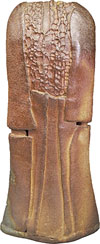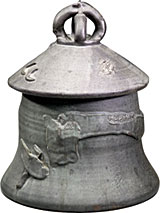
Clay his way: The pieces in Henry Bauer’s collection remain purposefully untitled. Artwork by Daniel Rhodes
|
A person could drown in testosterone looking at the Henry Bauer Collection in UNCA’s University Gallery! This remarkable display of ceramic works is nothing if not masculine. The pieces are, with very few exceptions, big, heavy and vertical. There is nothing delicate here, nothing remotely girly.
This extraordinary work is not from a collection put together by a rich art lover with the help of curators and gallery directors. It was gathered by Bauer, a roofer who took pots in exchange for fixing leaks and adding rooms. He has excellent taste. Exhibitor Val Cushing writes that this is ” … possibly the only collection in existence that started under such circumstances.
“It is now,” he declares, “among the most important collections in the country … “
Dianne Cable, who sometimes sits the gallery, reports that certain pieces had to be cleaned before the exhibit because they lived in the collector’s garden. “This kind of space, installed on pedestals, is not what these works are used to,” she notes.

Artwork by Robert Turner
|
Bauer lives in Alfred, New York, near Alfred University, where some of the world’s best-known ceramics teachers and students have worked and studied. He acquired his first work more than 25 years ago. Thinking that Robert Turner, in his clay-covered threadbare clothes, was poverty-stricken, Bauer offered to exchange a $600 roof repair for a couple of pots. Turner’s wife quickly informed Bauer that nothing in the studio sold for less than $2000. Bauer says he took cash for that job, but started to think seriously about what was going on with the ceramics at Alfred. He began offering work in exchange for pieces he liked, and acquired his first Turners for a three-week repair job on the foundation of the artist’s barn.
Megan Wolfe, who selected the works for the UNCA show, explains that these pieces come from the older generation of teachers. “They wore coats and ties,” she points out. “Val Cushing is 75 now, and Robert Turner died recently at the age of 93. They became more than artists to Henry – they became his friends.”
Wolfe has put a tremendous amount of effort into this opportunity – letting her students experience the best the world of clay has to offer without leaving their own campus. She drove twice to New York to select, pack and transport the work; she documented each piece; installed the exhibit; and has arranged for it to travel. The next venue will be Clemson University, where there are plans for a catalogue Wolfe will write.
Labels provide the name of the artist and basic information about materials and processes, but no titles or dates. And thus, the work can only be viewed in the context of the laid-back nature of the collection. Bauer’s preferences are clear. There is monumentality, and a directness: Some pieces could easily be artifacts from another part of the world.
Like Ted Randall’s vessels, for instance – dark, heavy and low, they might have been excavated from ancient China. Bill Parry makes works in mysterious shapes with more mysterious finishes. Some pieces look like groups of stones, and his small, rough-finished, deeply incised table is the show’s only functional work.
Most of what’s displayed is monochromatic, but Wayne Higby, John Gill and Don Rentz all show color here and there. Cushing exhibits a number of his tall signature pieces with their subtle glazes and stacked structure. Turner, however, is the star of the show. His works, some based on the shape of African mud huts, exude undeniable presence. In 1999, Turner would have been 87. Bauer reminisces: “I had some surgery [that year]. Bob Turner called to see about me. He was a good friend.”
This labor-for-pots exchange may be an unconventional way to build a collection, but Bauer looked carefully and trusted his instincts. Paying attention paid off: He now owns one of the nation’s premier collections of contemporary ceramics.
[Connie Bostic is an Asheville-based painter and writer whose recent work can be seen at the Meadows Museum in Shreveport, La.]
Alfred Ceramics: The Henry Bauer Collection shows at the University Gallery at UNCA through Tuesday, March 14. Gallery hours are 9 a.m.-6 p.m. 251-6876.


